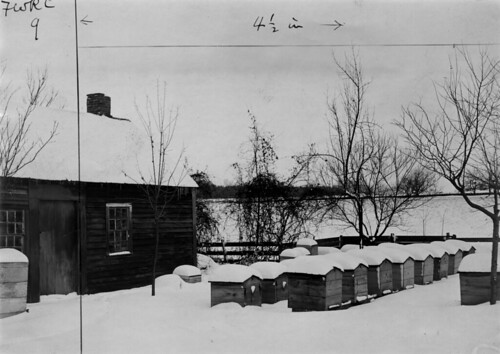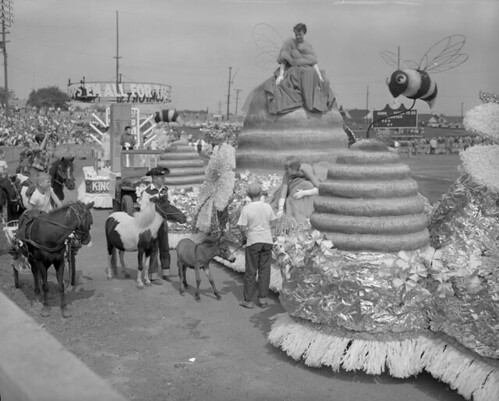There's a great community on Facebook called
Ethnobeeology. The moderator, Brian Dykstra, maintains the page to "share stories of bees and people," and he includes a range of images and stories from cultures all over the world to demonstrate the many ways people have documented their respect for living with bees. Brian was kind enough to respond to some questions so that I could post an interview with him here. He has other Facebook pages such as Ethnoherpetology and Ethnoornithology as well.
Mandy: How/when did you become interested in bees?
Brian: There are multiple reasons for my bee interest. I became interested in bees partly because of an interest in flowers! My interest in plants helped hone an attention to detail, form, and color in nature, and of course that is helpful when observing bees. After working for a season doing botany surveys, my colleague/team leader gave me the book Robbing the Bees: A Biography of Honey by Holley Bishop (2006). Later, I chose to conduct my Biology Masters research on the pollination of a rare flower, the golden inside out flower, because I wanted to explore a new area of botany (I was already interested in ethnobotany, taxonomy, and ecology). So I spent a good amount of time with some great helpers observing bee visitations to these beautiful flowers. We saw bumble bees and solitary bees primarily. Honey bees were not observed visiting the golden inside out flower in the two years worth of observations. We found that bumble bees are needed for this plant to make seeds for the next generation.
My interest in the diversity of human cultures and their relationships with the planet and its diverse life forms contributed to my interest in the cultural aspect of bees, beekeeping, and honey hunting. I have a Bachelor's degree in Anthropology and Environmental Policy, and have long been interested in ethnobiology (or the study of human relationships with other species). Traditional cultural relationships with plants and bees are both important to the future of life on this planet--being aware of and strengthening our relationships with life improves our quality of life.
Mandy: For readers who haven't seen it yet, could you describe your Ethnobeeology page?
Brian: Ethnobeeology is a page dedicated to sharing stories about human cultural relationships with the bees around the world. Bees are diverse and cultures are diverse. As Luisa Maffi (of Terralingua) and others have pointed out, cultural and linguistic diversity is positively related to biological diversity. I think people benefit from gaining an awareness and perspective of humans and bees that includes other peoples and places. I do not expect a beekeeper in Louisiana to take up Indonesian chanting and prayer when harvesting honey; I believe that awareness of the way other people, cultures, and countries respect, revere, and care for bees promotes harmony, both among humans and between humans and bees.
Mandy: When did you start Ethnobeeology, and what gave you the idea to start it?
Brian: I started the Ethnobeeology page in December of 2011 (it has been a whole year!). I know that many people are expressing an interest in learning about and helping bees (as well as being helped by bees), but often the contemporary information about bees is very scientific. I wanted to include the human element to bees. Truly I started the page as a way to initiate a personal study into human cultural relationships with bees around the world and through time.
Mandy: Where/how do you find your sources for Ethnobeeology?
Brian: I use books (libraries) and the internet. You will find most of my posts have a link to another website, or refer to a published book or article. I want readers to see the truth of the stories I share, and I want them to have a way to continue learning if it is a topic that interests them. I would not be able to share anything if other people had not already written and photographed and shared their experiences. So I owe so much of what I do to others. I want people who write about, photograph, and create art about bees and people to be credited, have their popularity increase, and have their stories and images available to people so that awareness of these stories increases.
Mandy: What are a couple things that anyone can do to help bees?
Brian: I think everyone can do something to improve their relationship with bees.
Learning more about them is one easy way. While tabling at an agricultural event with bee information, I had an encounter with someone who approached the display exclaiming, "I hate bees," but by the end of the conversation, he voiced respect and need for bees. It was his love for various bee-dependent fruits and nuts that helped bridge the gap. So learning the truth about bees and sharing it is a powerful way to help bees. Many people do not understand the importance of bees to wildflower and agricultural pollination. Additionally, there are other benefits to some species of bees such as honey, wax, and propolis (used in food, medicine, technology, etc.). Bees will continue to inspire us.
In order to help bees, we must be informed as to who they are. Start seeing bees. Slow down. Look at the flowers in your yard, neighborhood, and wherever you go. Not all bees look like honey bees. Becoming a bee-watcher is a great way to generate enthusiasm and passion for helping them.
Another great step towards helping bees is planting flowers. Planting flowers in your yard, in pots on your porch, or a community garden provides a means for bees to obtain their foods (nectar and pollen). Bees benefit from the preservation of wild areas. This is especially true because areas that are left to be wild spaces have many nesting opportunities for native bees (which nest in the ground, wood, twigs and stems). Planting a diverse set of native plants is a great way to positively impact the lives of bees near you.
Some people are helping renew interest in solitary bees, which can be amazing pollinators; although few people are aware of them, they make up over 80% of all bee species. These bees have often lived very close with humans without our notice. To learn about solitary bees I suggest http://solitarybee.com/ (which has a great blog) and Native Buzz, a citizen science project. Both of which maintain great Facebook pages (https://www.facebook.com/Solitary.bees and https://www.facebook.com/NBNSproject).
For some good reading about pollination, bees, and other pollinators, I suggest The Forgotten Pollinators by Stephen Buchmann and Gary Paul Nabhan (1997 paperback). For the cultural side of bees, I suggest The World History of Beekeeping and Honey Hunting by Eva Crane (1999). If your local library does not have these books, I suggest using their inter-library loan.
There are about 25,000 bees and 4,000 wasp species that are documented pollinators and "there are perhaps 40,000 species of bees alive today" (from The Forgotten Pollinators).
There are many ways to help bees, so this list is just the tip of the iceberg. Thank you for taking the time to write me and ask me questions.







